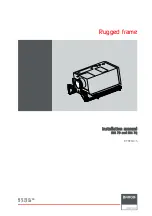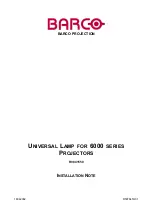
GLOSSARY
RGB Video
>
The video output of most computers. It can be analog or digital. Analog RGB video has
3, 4, or 5 wires; one for red, one for green, one for blue, and none, one or two for sync.
For three wire RGB, the green wire usually provides sync. (See also TTL Video).
Scan Frequency
>
The horizontal or vertical frequency at which images are generated.
Scan Line
>
One scan line is one horizontal line on the display.
SECAM
>
A video output format of some video tape and disk players (used primarily in France).
SECAM (Sequential Couleur â Mémoire) signals are similar in resolution and frequency
to PAL signals. The primary difference between the two standards is in the way color
information is encoded.
Setup Memory
>
A projector memory, which stores user-adjustable display settings. There are two types
of setup memories:
Input
and
Recall.
80th memory types store the same parameters. The
only difference is that Input memories store display settings for a particular physical
input (i.e., switcher 0, slot 1) and Recall memories can be used with any input.
Slidebar
>
A slider is a graphical display of an adjustment setting. The setting is displayed on a
percentage scale.
Source
>
A device, such as a computer or VCR, which may be connected to the projector for
display.
Spot Size
>
The diameter of the smallest dot that can be generated on the face of a CRT.
Sync
>
This term refers to the part of the video signal that is used to stabilize the picture. Sync
can take three forms:
1) ''Composite sync'' when the horizontal and vertical components are together on one
cable.
2) ''Sync on green'' when the sync is part of the green video.
3) ''Separate sync'' or ''H.SYNC and V.SYNC'' when the horizontal and vertical
components of the sync are on two separate cables.
Sync Width
>
The duration of each sync pulse generated by a computer. The sync width is part of the
blanking time.
TTL Video
>
A type of RGB video with digital characteristics.
Terminated
>
A wire connecting a single video source to a display device, such as a projector, must be
terminated by a resistance (usually 75 ohms for video).
Throw Distance
>
Also called ''Projector-to-screen Distance'', the distance between the front of the
projector's green lens and the screen.
Variable Scan
>
The ability of a projector to synchronize to inputs with frequencies within a specified
range.
A-6
Summary of Contents for Model 9
Page 1: ......
Page 44: ...INSTALLATION SETUP Figure 2 29 ACON Installation Examples 2 38...
Page 104: ...Physical Dimensions 5 5...
Page 105: ...5 6...
Page 113: ...A p p e n d i x B B 1...
Page 114: ...B 2...
Page 115: ...C 1...
Page 116: ...C 2...
Page 117: ...D 1...
Page 118: ...D 2...
Page 119: ...E 1...
Page 120: ...F 1...
Page 121: ...F 2...
Page 122: ...F 3...
Page 123: ...F 4...
Page 124: ...F 5...
Page 125: ...F 6...
Page 126: ...F 7...
Page 127: ...F 8...
Page 128: ...F 9...
Page 129: ...F 10...
Page 130: ...G 1...
Page 131: ...Index 1...
Page 132: ...Index 2...
















































